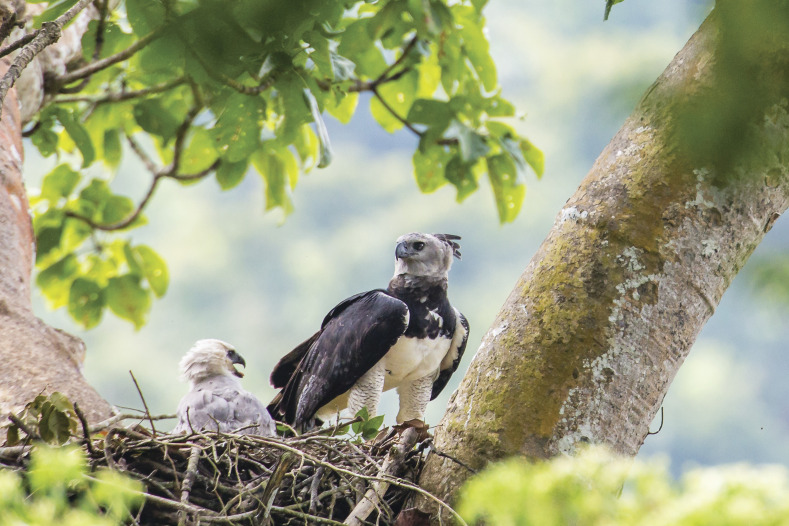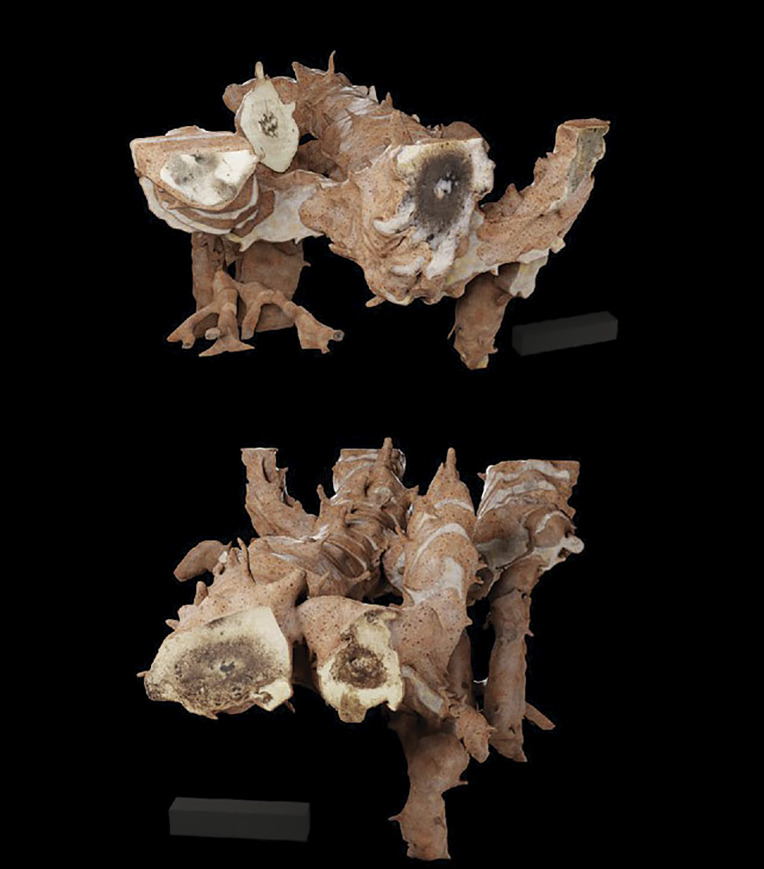APPLIED BIOLOGICAL SCIENCES
Harpy eagles. Image credit: Carlos Navarro (photographer).
Diversity, population trends, and conservation of raptors
Human activity harms raptors, and many species now face the risk of extinction. Carlos Cruz et al. examined conservation status, distribution patterns, endemism, geographic range, life-history traits, population trends, and species richness of all extant raptor species. The authors examined data from the BirdLife International database 2015 and the International Union for the Conservation of Nature and Natural Resources database 2017, and identified 557 extant raptor species, which represent 5% of all wild bird species. Most raptors are diurnal, and compared with nocturnal species, diurnal species have significantly larger geographic ranges and are found at lower latitudes. Overall, 30% of raptor species are at risk of extinction. The geographic range of around 28% of raptor species is limited to a single country. Raptor species richness varies around the globe. Whereas arid and temperate zones as well as polar regions exhibit the lowest number of raptor species, tropical regions, including the South American Andes, some Pacific islands, and Himalayan and Indo-Malayan regions, exhibit the greatest diversity of raptors. At the country level, Indonesia has the highest number of raptor species. According to the authors, the results suggest the need to enhance protected areas or create new reserves to protect threatened raptors, especially in China, India, Mongolia, Nepal, and Russia. — M.S.
ECONOMIC SCIENCES
Individualistic culture and intergenerational mobility
Where children grow up can significantly influence their chances of upward mobility in adulthood. However, the underlying mechanisms through which geographic location during childhood affects socioeconomic mobility remain unclear. Using data from prior research, Bryan Leonard and Steven Smith examined county-level earnings forecasts for US adults born between 1980 and 1986. The authors focused on predicted changes in individuals’ earnings at age 26 that were associated with living in a particular county until age 20. Individuals’ parents were either in the 25th or 75th percentile of income earnings. The authors also examined counties’ exposure to the historic US frontier during the 19th century. The historic frontier initially lacked social infrastructure and continues to be associated with individualistic culture. Growing up in counties that remained on the historic frontier for a longer period was associated with greater upward socioeconomic mobility, compared with growing up in counties that were settled more quickly. Specifically, an additional decade of exposure to the historic frontier was associated with a 25% increase in income mobility. The findings suggest that individualistic culture may exert a strong influence on intergenerational mobility, according to the authors. — M.S.
PHYSIOLOGY
Internal body clock and asthma severity
The severity of asthma tends to increase at night, but the extent to which the internal circadian system—as opposed to nocturnal environmental or behavioral factors, such as sleep—contributes to this phenomenon has been unclear. Frank Scheer et al. assessed variations in asthma severity in 17 patients over 3 weeks at home and in carefully controlled laboratory experiments that dissociated circadian effects from environmental and behavioral effects. In the 38-hour constant routine protocol, the participants stayed awake in a semirecumbent position and received snacks at fixed intervals. The 196-hour forced desynchrony protocol consisted of seven sequential 28-hour wake/sleep cycles, with all behaviors scheduled evenly across the circadian cycle. Pulmonary function followed an endogenous circadian pattern across protocols, with the worst function at night, around 4:00 AM. This result may have clinical relevance because symptom-driven bronchodilator inhaler use was four times more common at night than during the day. The circadian system and behaviors such as sleep had independent, additive effects on pulmonary function and inhaler use. Taken together, the findings demonstrate that the circadian system has a stand-alone impact on asthma severity. According to the authors, the study reveals the potential for improving therapeutic strategies by taking into account individuals’ internal biological time. — J.W.
EARTH, ATMOSPHERIC, AND PLANETARY SCIENCES
Artist’s illustration of lava from the Siberian Traps eruption flowing into the sea 252 million years ago. Image credit: Hewei Duan (artist) and Mingsong Li (Peking University, Beijing, China).
Carbon emissions during end-Permian mass extinction
The end-Permian mass extinction, which occurred 252 million years ago, is considered the most severe loss of biodiversity in Earth’s history. The extinction coincided with the volcanic eruption of the Siberian Traps and a significant increase in CO2 emissions, as seen in geological records, but the relationship between these events is unclear. Ying Cui et al. combined isotope records from biomarkers preserved in sediment samples, astrochronology, and an Earth system model to determine the source, pace, and total amount of CO2 emissions during the extinction. The authors used compound-specific carbon isotope analysis to determine the origins of carbon isotopes in organic matter from both terrestrial plants and marine algae preserved in sediment cores collected at the Finnmark Platform, off the coast of Norway. Next, the authors incorporated the isotope data into an ensemble of Earth system models. The results suggest that the end-Permian mass extinction coincided with massive and rapid emissions of predominantly volcanic CO2, resulting in significant acidification of the oceans and a rise in global temperatures from 25 to 40 °C. According to the authors, the results are consistent with the Siberian Traps eruption directly contributing to the end-Permian mass extinction. — M.H.
EVOLUTION
This artist’s rendition of the plant roots of Asteroxylon mackiei is based on a computer visualization of fossils. By revealing details of the root system, researchers are looking to better understand how modern plants evolved. Image credit: Matt Humpage (artist).
Digital reconstruction gets to the root of 400-million-year-old plant
Posted on September 3, 2021
David Adam
Researchers have managed to reconstruct the detailed 3-D structure of a fossilized plant more than 400 million years old. The ancient leafy organism, a relative of today’s clubmosses, grew in the Early Devonian era—a crucial time for the development of life on Earth that saw the evolution of complex plants that grew into the first forests. Published in eLife, the new computer visualization of the fossilized plant known as Asteroxylon mackiei reveals details of its rudimentary root system, potentially offering clues as to how modern plants emerged.





